Seri Muka is a Malaysian dessert consisting of two layers. The custard layer is infused with pandan extract, sitting on a coconut milk flavored glutinous rice base. The contrasting flavor of the two layers makes it the most popular nyonya kuih (dessert) among the Baba Nyonya and the Malays.
Seri Muka means beautiful face or pretty face. It is also a popular dessert in Indonesia. It also has a few different names, such as Puteri Salat, Kuih Salat and Kueh Talam Ketan Pandan.
Here is the comprehensive guide, which I hope is helpful to anyone who wants to make this Malaysian dessert.
Let’s get into the details right now.
Note: This post may contain affiliate links. Please read my privacy policy for more info. I may receive commissions for purchases made through links in this post. As an Amazon Associate, I earn from qualifying purchases.
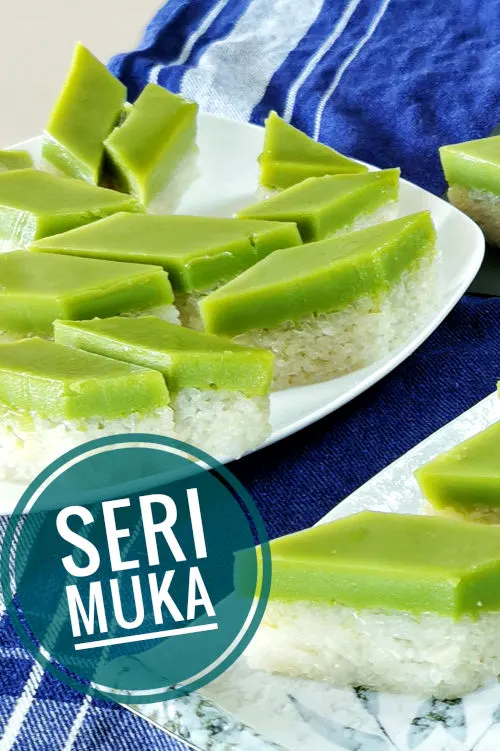
1. Prepare the rice layer
There are a few steps in preparing Seri Muka. First, prepare the rice and custard layers separately, then combine both and steam. Let’s start by preparing the rice layer since it takes time to soak rice.
- The glutinous rice is harder to cook through if not soaked thoroughly. Place it in a large bowl and add water to cover it. Let it sit for two hours or more so the rice is soft and easier to cook.
- After a few hours, drain the rice and place it in a mixing bowl.
- Season the rice with salt and sugar, then add coconut milk and water. Make sure the coconut milk and water drown the glutinous rice. Otherwise, there will not be enough liquid to cook through the rice. The amount of glutinous rice I use is 350g for an 8×8-inch square baking pan.
- Apply oil in the pan to prevent the rice from sticking. Next, pour the rice mixture and use a spoon to level it.
- Tuck a piece of pandan leaf in the rice.
- Steam the glutinous rice over medium heat for about thirty minutes or until the rice is soft and fluffy. Check that the rice is cooked. If it isn’t, drizzle two tablespoons of water and steam for five to ten minutes until fully cooked.
- After the glutinous has cooked, remove the pandan leaves.
- Mix the rice, salt, sugar, and coconut milk to ensure all are well mixed.
- Then flatten the glutinous rice with the back of a spoon or the dough cutter and press it down to form a tight layer. It will ensure the custard does not leak through it, ruining your layers. Keep it warm if the custard layer is not ready.
Note:
If you do not have fresh coconut milk, substitute it with boxed coconut milk. Some manufacturers may term it coconut cream. Whatever it is called, please ensure that it is the pure extract of the coconut for cooking, not for drinking. There is an easy way to check whether it is correct, as pure coconut milk has a fat content between 20 to 25 percent.
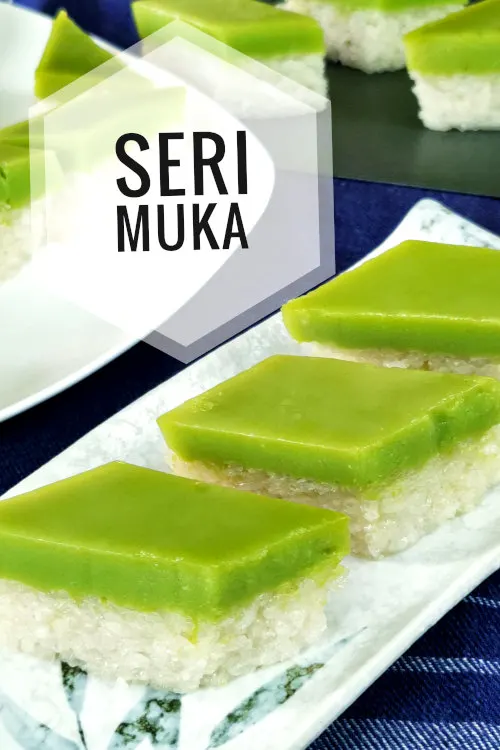
2. Prepare the custard layer
The custard layer on top of the rice is prepared separately, then poured and steamed together.
- Get 50g of pandan leaves and cut them with scissors into small pieces. If you use medium-sized pandan leaves, it should be about eight to ten pieces. (Please refer to the note below if you do not have pandan leaves.)
- Place the leaves in a blender, add 250 ml (one cup) of water, and grind finely.
- Pour the pandan juice through a wire mesh strainer or a fine sieve for a clean extract. Discard the leaves. Let the extract pass through the strainer twice for the best result.
- Get three large eggs, beat the eggs lightly, and avoid creating too many bubbles. If you use a blender or beat the eggs vigorously, they will trap air inside and expand. The resulting custard will not be smooth and may have holes due to the trapped air.
- Combine the sugar, all purpose flour, cornstarch, pandan extract, coconut cream, and beaten egg in a mixing bowl. The goal is to combine all the ingredients without creating bubbles.
- Pour the custard mixture into a small pot through a wire mesh strainer to catch all the possible lumps.
- Cook the custard mixture over low heat to about thirty percent until the first lump appears. It should be thick enough to coat the back of the spoon but still pourable. If you have a kitchen thermometer, this change will happen at about 60°C/140°F. Remove it from heat immediately once it reaches this temperature.
Note:
- If you skip this essential step, the ingredients in the custard will not become homogeneous while streaming with the glutinous rice. The flour will sink, causing the top to be softer than the bottom.
- If you do not have pandan leaves, try to get the store-bought pandan extract and follow the bottle’s instructions. Please use pandan extract, not artificial pandan essence, for the best result. If you use the pandan extract, add more water to return the same liquid amount for the custard.
- You can also add a few drops of artificial color to make it greener. However, I prefer to use more pandan leaves while making the extract, which yields an attractive green color without artificial coloring.
3. Assemble the glutinous rice and custard layers
Now it comes to steaming the semi-cooked custard with the glutinous rice.
- Scrape the surface of the glutinous layer with a fork so that the surface becomes slightly uneven. The uneven surface helps to let the custard layer stick to it firmly.
- Pour the thickened custard onto the packed glutinous rice layer (bottom layer) while still hot, and remember to pour through a wire mesh strainer to remove any lumps. Pour the custard mixture as close to the rice as possible to prevent bubbles. Rice must be hot and moist when the custard is added, or the two layers won’t stick together.
- Use the corner of a paper towel to break all the air bubbles.
- Cover the Seri Muka with aluminum foil, which helps prevent water condensation from dropping onto the surface, causing an uneven appearance. Alternative method: Place two long chopsticks on the steamer, then cover it with a lid wrapped with a cloth.
- Reduce heat to the lowest possible to let the custard set slowly and create a smooth surface. Keep steaming with water below boiling point, with the steamer’s cover slightly ajar if necessary.
- You can vary the time required to steam the Seri Muka from forty minutes to an hour. The best way is to be patient and use a slow flame to steam. Vigorous high heat will create an uneven surface. You can open the aluminum foil to check the doneness at the 40th minute. You can cover and continue steaming it if the center is not fully set. The Seri Muka is done when inserting a toothpick and coming out clean.
- Remove the Seri Muka, set it aside to cool thoroughly, and the custard (top layer) set.
4. How to cut, serve, and keep Seri Muka
- You must wait until the Seri Muka is cold before lifting it from the mold. It may take one to two hours for the custard layer to set.
- Cut the Seri muka into pieces with a knife or plastic dough cutter and wipe with oil to prevent sticking.
- Seri Muka can be refrigerated for up to 2-3 days. It is best to wrap it with a plastic sheet of cling wrap to prevent the surface from exposing to the air.
- To reheat Seri Muka, bring it to room temperature, then steam for about 4 minutes. Then, let it cool to room temperature before serving.
Seri Muka is a dainty and delightful dessert that is fragrant, sweet, and full of texture. It is sold in morning markets, school canteens, and traditional cake shops. Try it, and I hope you will love it.
5. Other Malaysian desserts/snacks you should try
Ondeh ondeh is a sweet delicacy with palm sugar wrapped in glutinous rice flour dough and coated with salted grated coconut.
Curry puff is the most lovable snack you can find at every turn and corner in Malaysia. It is a snack enjoyed by different ethnic groups in this multicultural country by everyone.
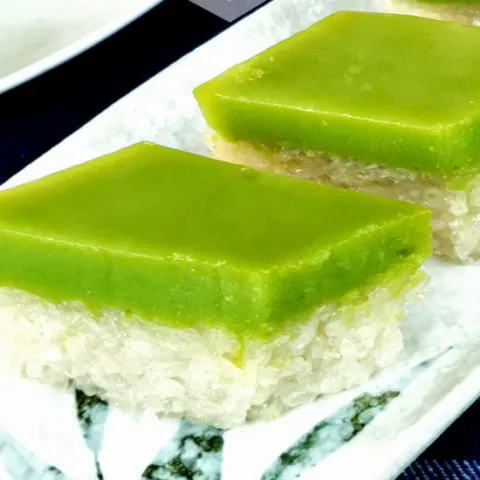
Seri Muka- How to make a delightful Malaysian dessert
Seri Muka is a Malaysian dessert consisting of two layers, a custard layer infused with pandan (screwpine) extract on coconut milk flavored glutinous rice base. The contrasting flavor of the two layers makes it a delightful dessert among the Baba Nyonya and the Malays.
Ingredients
Ingredients A (Glutinous Rice Layer)
- 350g glutinous rice
- 130ml coconut milk
- 90ml water
- 1 tsp salt
- 1 tbsp sugar
- 1 piece pandan leaf
Ingredients B (Custard layer)
- 135g sugar
- 50g all-purpose flour
- 15 g cornstarch
- 150ml pandan extract (see note)
- 150ml coconut milk
- 3 large eggs
Instructions
Prepare the rice layer
- Soak the glutinous rice in water for two hours.
- Drain the rice and season with salt and sugar, then add coconut milk and water.
- Pour the rice mixture into the pan.
- Tuck a piece of pandan leaf in the rice.
- Steam the glutinous rice over medium heat for about thirty minutes or until the rice is soft and fluffy.
- After the glutinous has cooked, remove the pandan leaves.
- Press down the glutinous rice with the dough cutter to form a tight layer.
Prepare the custard layer
- The custard layer on top of the rice is prepared separately, then poured and steamed together.
- Cut the pandan leaves into small pieces.
- Place the leaves in a blender, add one cup of water and grind finely.
- Pour the pandan juice through a wire mesh strainer to get a clean extract.
- Beat three eggs lightly.
- Combine the sugar, regular flour, cornstarch, pandan extract, coconut cream, and beaten egg in a mixing bowl.
- Pour the custard mixture into a small pot through a wire mesh strainer to catch all the lumps that may exist.
- Cook the custard mixture over low heat until the first lump appears. Remove it from heat immediately.
Assemble the glutinous rice and custard layers
- Pour the thickened custard onto the packed glutinous rice layer while still hot.
- Use the corner of a paper towel to break all the bubbles.
- Cover the Seri Muka with aluminum foil.
- Steam over low heat with the cover slightly ajar for 40-60 minutes, until the custard is set. The Seri Muka is done when inserting a toothpick and coming out clean.
- Remove the Seri Muka, set it aside to cool thoroughly before cutting it into pieces to serve.
Notes
Pandan extract is made from 50g pandan leaves and 250ml water.
Recommended Products
As an Amazon Associate and member of other affiliate programs, I earn from qualifying purchases.
-
 Pro Dough Pastry Scraper/Cutter/Chopper Stainless Steel Mirror Polished with Measuring Scale Multipurpose- Cake, Pizza Cutter - Pastry Bread Separator Scale Knife (1)
Pro Dough Pastry Scraper/Cutter/Chopper Stainless Steel Mirror Polished with Measuring Scale Multipurpose- Cake, Pizza Cutter - Pastry Bread Separator Scale Knife (1) -
 Hakubai Japanese Sweet Rice | 2 Lbs - 2 Pack | Glutinous Sweet Rice for Mochi Gome | 4 Lbs Total
Hakubai Japanese Sweet Rice | 2 Lbs - 2 Pack | Glutinous Sweet Rice for Mochi Gome | 4 Lbs Total -
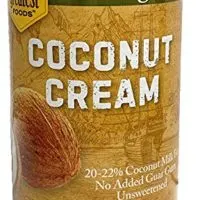 Nature's Greatest Foods, Organic Coconut Cream, No Guar Gum, Unsweetened, 13.5 Ounce (Pack of 12)
Nature's Greatest Foods, Organic Coconut Cream, No Guar Gum, Unsweetened, 13.5 Ounce (Pack of 12) -
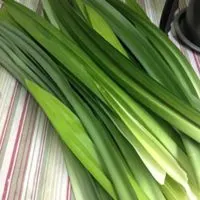 Fresh Pandan Leaves 4 oz. ( Rampe, La Dua, ใบเตยสด )
Fresh Pandan Leaves 4 oz. ( Rampe, La Dua, ใบเตยสด )
Nutrition Information:
Yield: 20 Serving Size: 1Amount Per Serving: Calories: 95Total Fat: 4gSaturated Fat: 3gTrans Fat: 0gUnsaturated Fat: 1gCholesterol: 28mgSodium: 130mgCarbohydrates: 14gFiber: 0gSugar: 7gProtein: 2g
This data was provided and calculated by Nutritionix on 11/20/2021

Traditional Malaysian Desserts You’ll Love
Sunday 23rd of February 2025
[…] 15. Seri Muka […]
Joan
Sunday 21st of November 2021
Can you clarify whether to use coconut milk as specified in the recipe versus your recommended coconut cream product at the end of the recipe? There is a difference in the consistency that may be important. Thank you!
KP Kwan
Sunday 21st of November 2021
The fresh coconut liquid extract from the coconut (Santan as in Malay) is translated as cream and milk at times. Whatever it is called, please make sure that it is the pure extract of the coconut for cooking, not for drinking. Pure coconut extract has a fat content between 20 to 25 percent. If it is far lower than that and added with other ingredients, chances are it is a diluted drink (like drinking milk) rather than for making dessert or for cooking. Please check the information on the packaging when you purchase it.
Troquier
Saturday 20th of November 2021
Hi. Thanks very much for your recipe. I have 2 questions. 1/ do you not use bluepea flower to add some color to the glutinous rice. 2/ living overseas it is not easy to get that much pandan leaves. Does it mean that if pandan paste is used, I will need to use 250ml to dilute it ? Thanks in advance for your comments.
KP Kwan
Sunday 21st of November 2021
HI Trouquier, 1. It will look more colorful if you add the blue pea flower. By all means, use it if you have it. 2. Since the paste is concentrated, please use it to constitute the same amount of pandan extract in the recipe for the same consistency. Thanks, KP Kwan
KP Kwan
Saturday 20th of November 2021
Hi, this is KP Kwan. I am happy to see you in this comment area, as you have read through my recipe. I am glad to reply to any questions and comments as soon as possible.